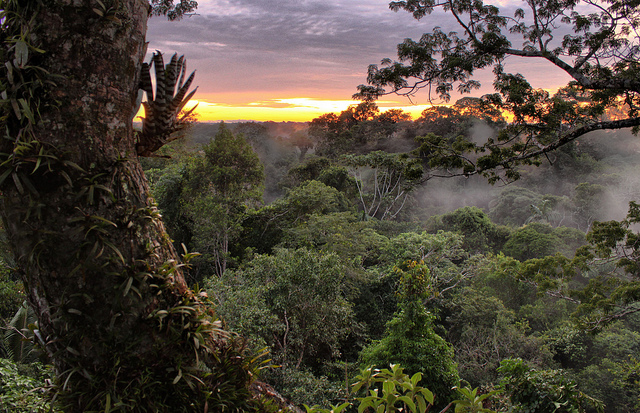
by DGR News Service | Jun 17, 2014 | Biodiversity & Habitat Destruction, Indigenous Autonomy
Deep Green Resistance stands in sympathy and solidarity with Don Celestino Bartolo and the farmers and residents of the municipality of Juchitan de Zaragoza as well as all those who live on the Isthmus of Tehuantepec, as they suffer and resist Gas Natural Fenosa’s Biío Hioxo Wind Energy project. Like most large infrastructure projects, the Biío Hioxo Energy project ignores how indigenous communities use the land for food, sacred places, and community integrity. This project harms the land by destroying soils, forests, and natural spaces, as well as with noise and visual pollution.
Projects like this threaten the way of life of the residents of Juchitan de Zaragoza and the Isthmus of Tehuantepec, and destroy the land. It is typical of the destructiveness of civilization and the unbridled greed of capitalism. Biío Hioxo Energy also serves as an object lesson in the folly of green technology, and deserves our condemnation and resistance.
Indigenous peoples have always been at the forefront of the struggle against the dominant culture’s ecocidal violence. We are heartened by the strength of the people of Tehuantepec, who are resisting with strength and desperation. DGR offers its support and encouragement to those on the front lines of the fight to save the planet, and despite our lack of experience and membership in the region we will support the struggle in whatever way we can.
For more information on the Biío Hioxo project, see http://www.cipamericas.org/archives/12042

by DGR News Service | May 22, 2014 | Indigenous Autonomy, Mining & Drilling
By Agence France-Presse
The license comes just days after a petition for a referendum on the project was rejected by the country’s election authorities.
The action, signed by Environment Minister Lorena Tapia, gives a state company, Petroamazonas, rights to develop an oil field in part of the forest designated a UNESCO Biosphere Reserve.
Home to two indigenous tribes that have resisted contact with the outside world, the rainforest park covers an expanse of more than 9,800 square kilometers [3784 square miles] between two rivers.
The field, known as Tiputini, is part of a vast bloc that lies partially within the park with proven reserves of 920 million barrels of crude.
Petroamazonas was also granted a license to develop the Tambococha field, which lies outside the park but within the same oil development bloc.
Yasunimos, an environmentalist group, has fought government plans to open the park to oil development, gathering what it said were nearly 728,000 signatures on a petition to put it to a referendum.
But on May 9, Ecuador’s National Electoral Council invalidated half the signatures and rejected the petition, clearing the way for Thursday’s action.
The decision, however, could be appealed to the country’s constitutional court.
In October, Ecuador’s Congress approved a government plan to develop the Yasuni oil reserves, on the promise that revenues would be used to eradicate poverty.
From Physorg: http://phys.org/news/2014-05-ecuador-oil-amazon-reserve.html
by DGR News Service | Apr 27, 2014 | Obstruction & Occupation, Toxification
By Dan Collyns / The Guardian
Around 500 Achuar indigenous protesters have occupied Peru’s biggest oil field in the Amazon rainforest near Ecuador to demand the clean-up of decades of contamination from spilled crude oil.
The oilfield operator, Argentine Pluspetrol, said output had fallen by 70% since the protesters occupied its facilities on Monday – a production drop of around 11,000 barrels per day.
Native communities have taken control of a thermoelectric plant, oil tanks and key roads in the Amazonian region of Loreto, where Pluspetrol operates block 1-AB, the company said on Thursday.
Protest leader, Carlos Sandi, told the Guardian that Achuar communities were being “silently poisoned” because the company Pluspetrol has not complied with a 2006 agreement to clean up pollution dating back four decades in oil block 1-AB.
“Almost 80% of our population are sick due to the presence of lead and cadmium in our food and water form the oil contamination,” said Sandi, president of FECONACO, the federation of native communities in the Corrientes River.
Pluspetrol, the biggest oil and natural gas producer in Peru, has operated the oil fields since 2001. It took over from Occidental Petroleum, which began drilling in 1971, and, according to the government, had not cleaned up contamination either.
Last year, Peru declared an environmental state of emergency in the oil field.
But Sandi said the state had failed to take “concrete measures or compensate the native people” for the environmental damage caused.
He claimed Achuar communities were not receiving their share of oil royalties and the state had failed to invest in development programmes in the Tigre, Corrientes and Pastaza river basins that had been most impacted by oil exploitation.
He said the Achuar were demanding to meet with the central government to talk about public health, the environment and the distribution of oil royalties.
“We aren’t against oil exploitation or development we are calling for our rights to be respected in accordance with international laws,” he said.
“Conversations are under way to bring a solution to the impasse,” Pluspetrol told Reuters. “A government commission is there and we hope this is resolved soon.”
Over the past year, the Peruvian government has declared three environmental emergencies in large areas of rainforest near the oil field after finding dangerous levels of pollution on indigenous territories.
Peru’s Environment Ministry said in a statement last week that a commission formed by government and company representatives has been assigned to work with communities to tackle pollution problems and other concerns.
From The Guardian: http://www.theguardian.com/environment/2014/apr/25/indigenous-protesters-occupy-perus-biggest-amazon-oilfield

by DGR News Service | Apr 6, 2014 | Colonialism & Conquest, Defensive Violence, Mining & Drilling, NEWS, Property & Material Destruction
By Mindanao Examiner
New People’s Army rebels on Saturday raided a mining firm in the southern Philippine province of Agusan del Norte, reports said.
Reports said the rebels swooped down on Philippine Alstron Mining Company on the village of Tamamarkay in Tubay town and overpowered the security guards without firing a single shot before they torched several trucks and other heavy equipment.
The rebels also seized at least 6 shot guns and short firearms from the company’s security arsenal. There were no reports of casualties.
The raid came following threats made by the NPA on mining firms operating in the southern Philippines.
Just last month, rebel forces attacked a police base and government troops in Davao del Sur’s Matanao as punishment for their “reign of terror” against indigenous tribes and other communities opposing mining operations in the province.
Dencio Madrigal, a spokesman for the NPA-Valentine Palamine Command, said the deadly attacks were a punishment for police and military units protecting Glencore Xstrata. He accused the mining firm of exploiting nearly 100,000 hectares of ancestral lands of indigenous Lumad Blaans tribes, and peasants in the region.
Jorge Madlos, a regional rebel spokesman, also warned mining firms and fruit plantations in the region, saying military operations in Mindanao have escalated and have become more extensive with the aim to thwart the ever growing and widespread people’s protest against destructive mining operations and plantations.
Madlos said among their targets are Russell Mines and Minerals, Apex Mining Corp. and Philco in southern Mindanao; Dolefil, Del Monte and Sumifru plantations in northern Mindanao; TVI Resource Development Philippines in western Mindanao whose operations inside the ancestral domain of indigenous Subanen and Moro tribes are being opposed by villagers.
NPA and Moro rebels had previously attacked TVI Resources in Zamboanga province.
“If one recalls, more than 400 families were forced to evacuate their ancestral lands because of TVI and the ruthless military operations that ensued to protect it in Buug, Zamboanga del Sur. In order to defend the people’s human rights and general wellbeing, the NPA launched tactical offensives against TVI as well as against units of the AFP-PNP-CAFGU protecting it, such as the ambush on February 2012 that hit elements of the army intelligence group operating on the behest of TVI and the imposition of the local government to allow TVI mining operations on Subanen ancestral lands is one of the bases the NPA raided on April 9, 2012 the PNP station in Tigbao, Zamboanga del Sur,” Madlos said.
NPA rebels also intercepted a group of army soldiers who were using a borrowed truck from TVI and disarmed them in Diplahan town in Zamboanga Sibugay province two years ago. The rebels also burned the truck before releasing the soldiers.
“In view of these events, the NDFP in Mindanao calls upon the Lumad and Moro peoples, peasants and workers, religious and other sectors to further strengthen their unity and their courage to oppose the interests of imperialist mines and plantations, which are exceedingly damaging to Mindanao, to its people and to the environment. We call upon the units of the NPA in Mindanao to be ever more daring in their defense of people’s interests against the greed and rapacity of the local ruling classes and their imperialist master,” Madlos said.
TVI Resource Development Philippines has repeatedly denied all accusations against them. It recently ended its gold mining operation in Mount Canatuan in Zamboanga del Norte’s Siocon town after several years of operations and now has a gold-silver project in the town of Bayog in Zamboanga del Sur province and a nickel plant in Agusan del Norte province.
From Mindanao Examiner: http://www.mindanaoexaminer.com/news.php?news_id=20140405091630
Photo by Matthew De Zen on Unsplash
by DGR News Service | Mar 20, 2014 | Climate Change
By Renee Lewis / Al Jazeera
Climate change may be stunting fish growth, a new study has said. Fish sizes in the North Sea have shrunk dramatically, and scientists believe warmer ocean temperatures and less oxygenated water could be the causes.
The body sizes of several North Sea species have decreased by as much as 29 percent over a period of four decades, according to the report, published in the April issue of Global Change Biology.
The report presents evidence gathered as researchers followed six commercial fish species in the North Sea over 40 years. Their evidence showed that as water temperatures increased by 1 to 2 degrees Celsius, an accompanying reduction in fish size was observed.
It is generally accepted among scientists that decreased body size is a universal response to increasing temperatures, known as the “temperature size rule,” the report said. But before this report, led by scientists at Scotland’s University of Aberdeen, there was no empirical evidence showing this response in marine fish species.
The scientists warned that fish stunting cannot be unequivocally blamed on temperature changes, but they did observe fish stunting across varying species and backgrounds that coincided with a period of increasing ocean temperature.
Other factors that could have influenced fish size include fisheries-induced evolution and intensive commercial fishing — which favors larger specimens. But, the scientists said, these causes would not be likely to affect growth rates across species, which was observed in the North Sea study.
Scientists at the University of Washington have been working on a similar study, looking at many species of fish from Alaska to California. Tim Essington, an associate professor of aquatic and fishery sciences at UW who is working on the study, said he was looking into whether changes in fish body size could be related to environmental parameters.
“We haven’t seen the same strong response,” Essington told Al Jazeera. “But we have seen variation in the sizes of some stocks, like halibut. Its body size has been shrinking sharply over the past 10 years, and has resulted in reduced catch quotas and higher prices at the supermarket.”
He said various factors explain why UW results were different from those of the Scottish team. University of Aberdeen scientists were looking at a much more localized area and a unique data set, and had many more years of data to make comparisons.
Overall, Essington said the Aberdeen findings represented a plausible hypothesis that should be looked at more closely, and that warmer temperatures could explain the stunting.
“Fish aren’t any different than us. It’s all about the difference between how much we eat and how much energy we expend. And they’re arguing that temperature is changing the fishes’ energy versus expension rates,” which could result in smaller sizes, Essington said.
The Aberdeen findings echoed earlier model-derived predictions that fish would shrink in warmer waters. Those projections for future fish size reduction are already being seen in the North Sea, scientists said.
The first global projection of the potential for fish stunting in warmer, less oxygenated oceans was carried out by the University of British Columbia in 2012, and published in the journal Nature Climate Change.
The projection said changes in ocean and climate systems by 2050 could result in fish that are 14 to 24 percent smaller globally.
“It’s a constant challenge for fish to get enough oxygen from water to grow, and the situation gets worse as fish get bigger,” said Daniel Pauly, principal investigator with the University of British Columbia’s Sea Around Us Project, and the co-author of the UBC study.
The study warned that strategies must be developed to curb greenhouse-gas emissions or risk disrupting food security, fisheries and the very way ocean ecosystems work.
From Al Jazeera America: http://america.aljazeera.com/articles/2014/3/19/report-climate-changestuntingfish.html

by DGR News Service | Mar 18, 2014 | Toxification
By Reuters
A major oil pipeline owned by Sunoco Logistics Partners LP leaked thousands of gallons of crude oil into a nature preserve in southwest Ohio late on Monday.
Between 7,000 and 10,000 gallons (26,000-38,000 liters) of sweet crude leaked into the Oak Glen Nature Preserve about a quarter of a mile from the Great Miami River, according to early estimates from the Ohio Environmental Protection Agency.
The leak, which occurred on a line operated by Mid-Valley Pipeline Co, a division of Sunoco, was discovered at 8:20 p.m. EDT on Monday (0020 GMT Tuesday). The company shut the line, which helped reduce the pressure of the leaking oil, an EPA spokeswoman said, but it was unclear if oil was still spewing from the pipe.
Some oil reached a wetland a mile away and on Tuesday, clean-up crews were preparing to vacuum the wetland, located 20 miles north of Cincinnati.
The oil did not appear to have reached the Great Miami River, though tests were still being completed, the EPA said.
“The extent of impact to the resource is currently unknown,” said a statement from the Great Parks of Hamilton County, which oversees the Oak Glen preserve. “The EPA is assessing the situation to determine appropriate action.”
Sunoco was not immediately available for comment.
The pipeline is part of Sunoco’s mid-west system that runs about 1,000 miles from Longview, Texas to Samaria, Michigan, providing crude oil to a number of refineries, primarily in the U.S. Midwest.
Read more from The Raw Story: http://www.rawstory.com/rs/2014/03/18/major-oil-pipeline-leaks-more-than-7000-gallons-of-crude-oil-into-ohio-nature-preserve/




